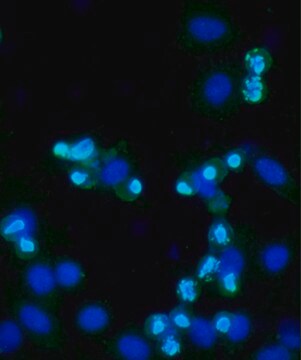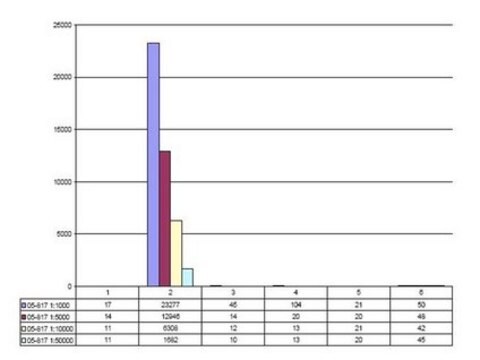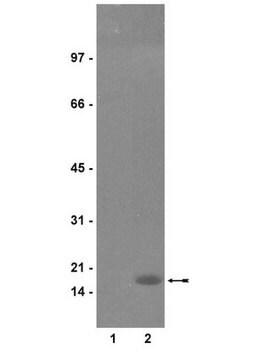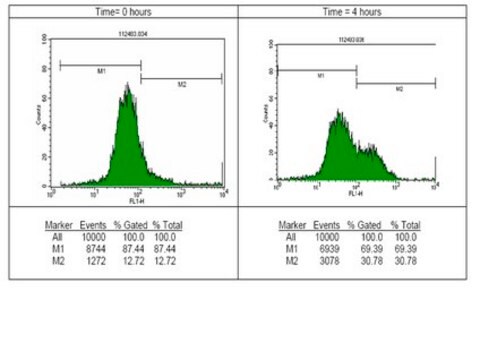일반 설명
We are committed to bringing you greener alternative products, which adhere to one or more of The 12 Principles of Green Chemistry.This antibody is Preservative-free, produced without the harm or sacrifice of animals and exceptionally stable to allow for ambient shipping and storage if needed and thus aligns with "Waste Prevention", "Designing Safer Chemicals" and "Design for Energy Efficiency".
Click here for more information.
ZooMAb antibodies represent an entirely new generation of recombinant monoclonal antibodies.
Each ZooMAb antibody is manufactured using our proprietary recombinant expression system, purified to homogeneity, and precisely dispensed to produce robust and highly reproducible lot-to-lot consistency. Only top-performing clones are released for use by researchers. Each antibody is validated for high specificity and affinity across multiple applications, including its most commonly used application. ZooMAb antibodies are reliably available and ready to ship when you need them.
Learn more about ZooMAb here.특이성
Clone 63-1C-8 is a ZooMAb rabbit recombinant monoclonal antibody that specifically detects Histone H3 phosphorylated on serine 10. It targets an epitope within 14 amino acids surrounding phosphoserine 10 from the N-terminal region.
면역원
KLH-conjugated linear peptide corresponding to 14 amino acids surrounding phosphoserine 10 of human Histone H3.
애플리케이션
Anti-phospho Histone H3 S10, clone 63-1C-8 ZooMAb, Cat. No. ZRB1226, is a recombinant rabbit monoclonal antibody that targets phospho-Histone H3 (Ser10) and has been tested for use in Dot Blot, Flow Cytometry, Immunocytochemistry, Peptide Inhibition Assay, and Western Blotting.
Flow Cytometry Analysis: 0.01 μg from a representative lot detected phospho-Histone H3 (Ser10) in one million Jurkat cells.
Immunocytochemistry Analysis: A 1:100 dilution from a representative lot detected phospho-Histone H3 (Ser10) in HeLa, A431, HUVEC, and NIH 3T3 cells.
Dot Blot Analysis: Representative lot was tested on AbSurance Histone Peptide Microarray.
Peptide Inhibition Assay Analysis: 1:100 dilution from a representative lot did not detect the target band in acid extract from HeLa cells treated with colemid (50 ng/ml) when preblocked with the S10 phosphopeptide, but detected the band when the corresponding non-phosphopeptide was used.
Note: Actual optimal working dilutions must be determined by the end user as specimens and experimental conditions may vary.
표적 설명
Histone H3.1t (UniProt: Q16695; also known as H3/t, H3t, H3/g) is encoded by the HIST3H3 (also known as H3FT) gene (Gene ID: 8290) in human. Histone H3 has two main variants, H3.1 and H3.3, which show different genomic localization patterns in animals. The H3.1 and H3.3 complexes also possess distinct histone chaperones, CAF-1 and HIRA, which play important role in mediating DNA-synthesis-dependent and -independent nucleosome assembly. It has been reported that Histone H3.1 serves as the canonical histone, which is incorporated during DNA replication, whereas H3.3 acts as the replacement histone that can be incorporated outside of S-phase during chromatin-disrupting processes like transcription. Histone H 3.1 is a core component of nucleosome that is present only in mammals and is usually enriched in acetylation of lysine 14 and demethylation of lysine 9 (with initial methionine removed; HeK9Me2). It is expressed during S phase and its expression decreases significantly as cell division slows down during the process of differentiation. Phosphorylation of serine 10 (with initiator methionine removed) in the tails of histone H3 is an important modification that is involved in both transcription and cell division. This phosphorylation is mainly achieved by the action signaling as well as mitotic kinases. This phosphorylation is reported to be dependent on the post-translational modification of neighboring amino acids. A reduction in methylation of lysine 9 can increase phosphorylation of serine 10, but demethylation of lysine 9 reduces serine 10 phosphorylation. This ZooMAb recombinant monoclonal antibody, generated by our propriety technology, offers significantly enhanced specificity, affinity, reproducibility, and stability over conventional monoclonals. (Ref.: Prigent, C., and Dimitrov, S. (2003). J. Cell Sci. 116(18); 3677-3685; Stroud, H., et al (2012). Proc. Natl. Acad. Sci. USA 109(14); 5370-5375).
물리적 형태
Purified recombinant rabbit monoclonal antibody IgG, lyophilized in PBS with 5% Trehalose, normal appearance a coarse or translucent resin. Contains no biocide or preservatives, such as azide, or any animal by-products. Larger pack sizes provided as multiples of 25 μL.
재구성
30 μg/mL after reconstitution at 25 μL. Please refer to guidance on suggested starting dilutions and/or titers per application and sample type.
저장 및 안정성
Recommend storage of lyophilized product at 2-8°C; Before reconstitution, micro-centrifuge vials briefly to spin down material to bottom of the vial; Reconstitute each vial by adding 25 μL of filtered lab grade water or PBS; Reconstituted antibodies can be stored at 2-8°C, or -20°C for long term storage. Avoid repeated freeze-thaws.
법적 정보
ZooMAb is a registered trademark of Merck KGaA, Darmstadt, Germany
면책조항
Unless otherwise stated in our catalog or other company documentation accompanying the product(s), our products are intended for research use only and are not to be used for any other purpose, which includes but is not limited to, unauthorized commercial uses, in vitro diagnostic uses, ex vivo or in vivo therapeutic uses or any type of consumption or application to humans or animals.










